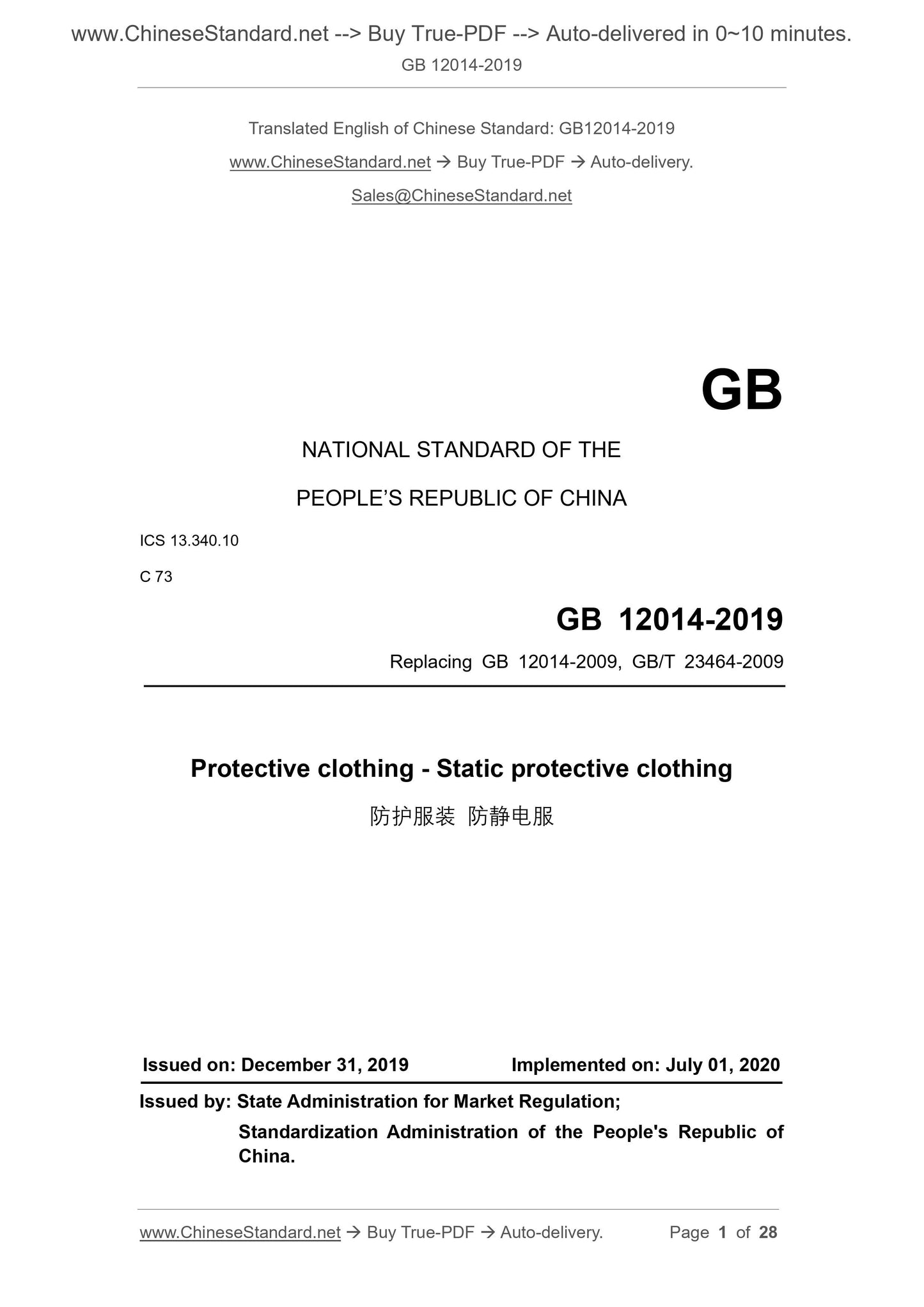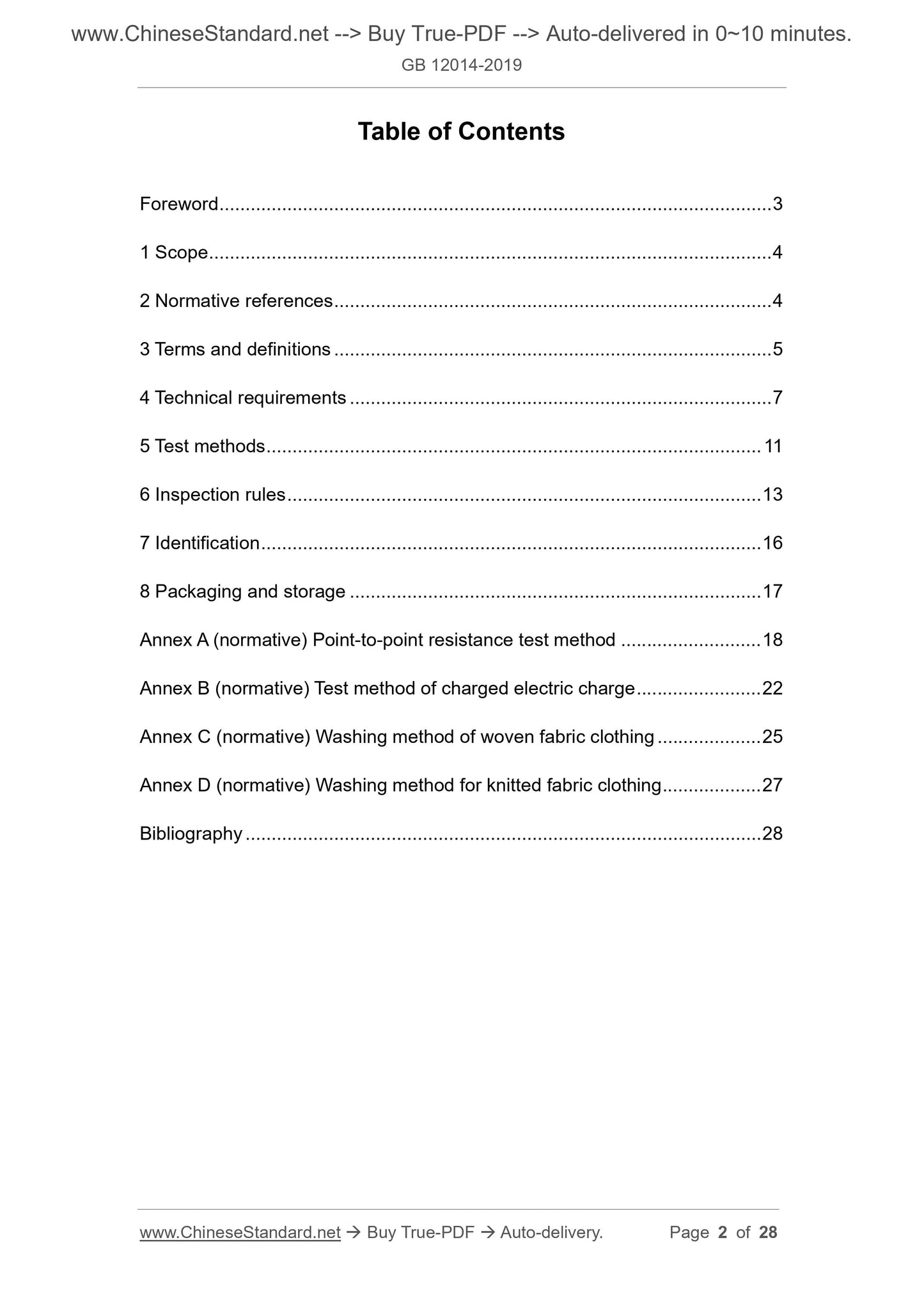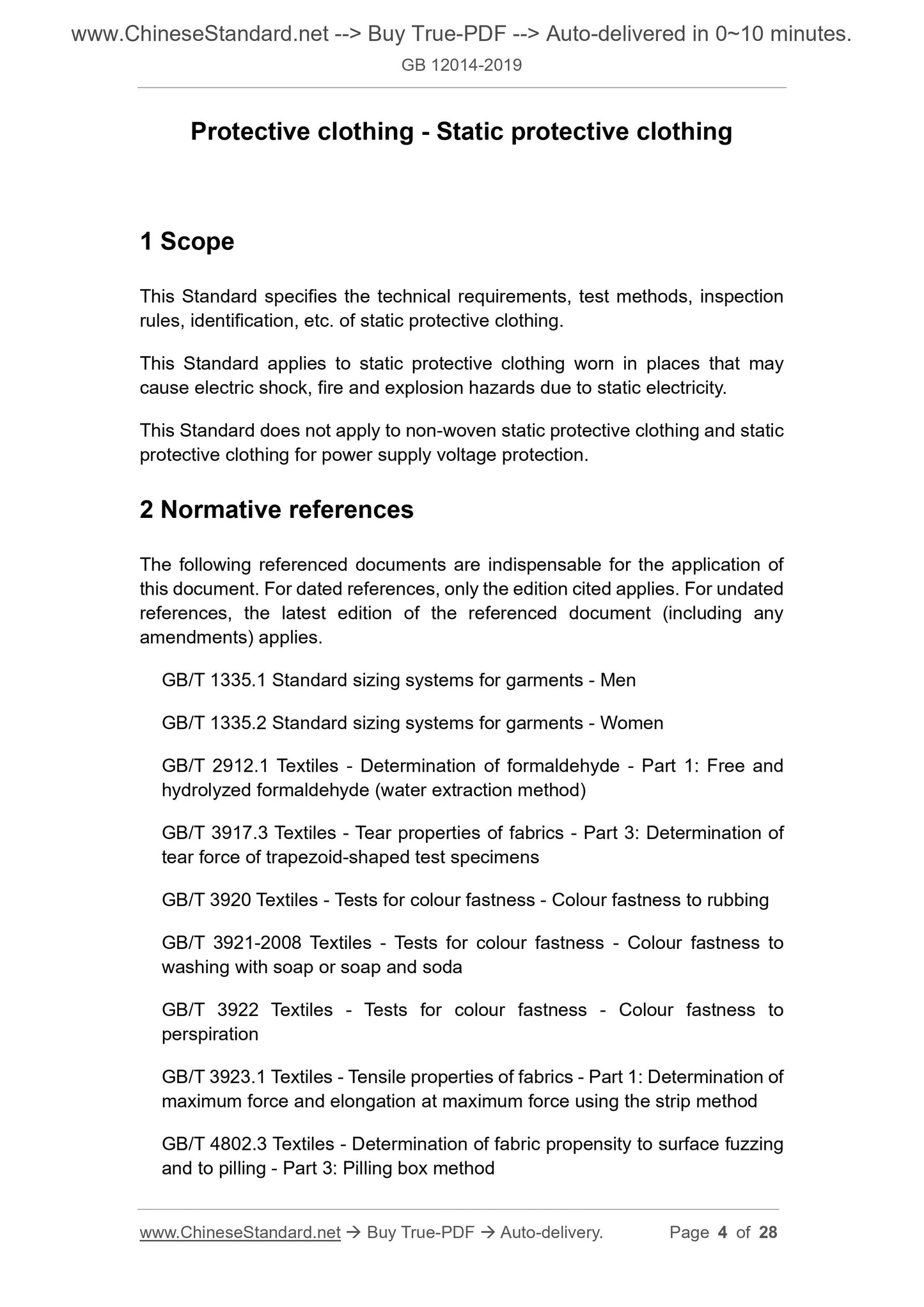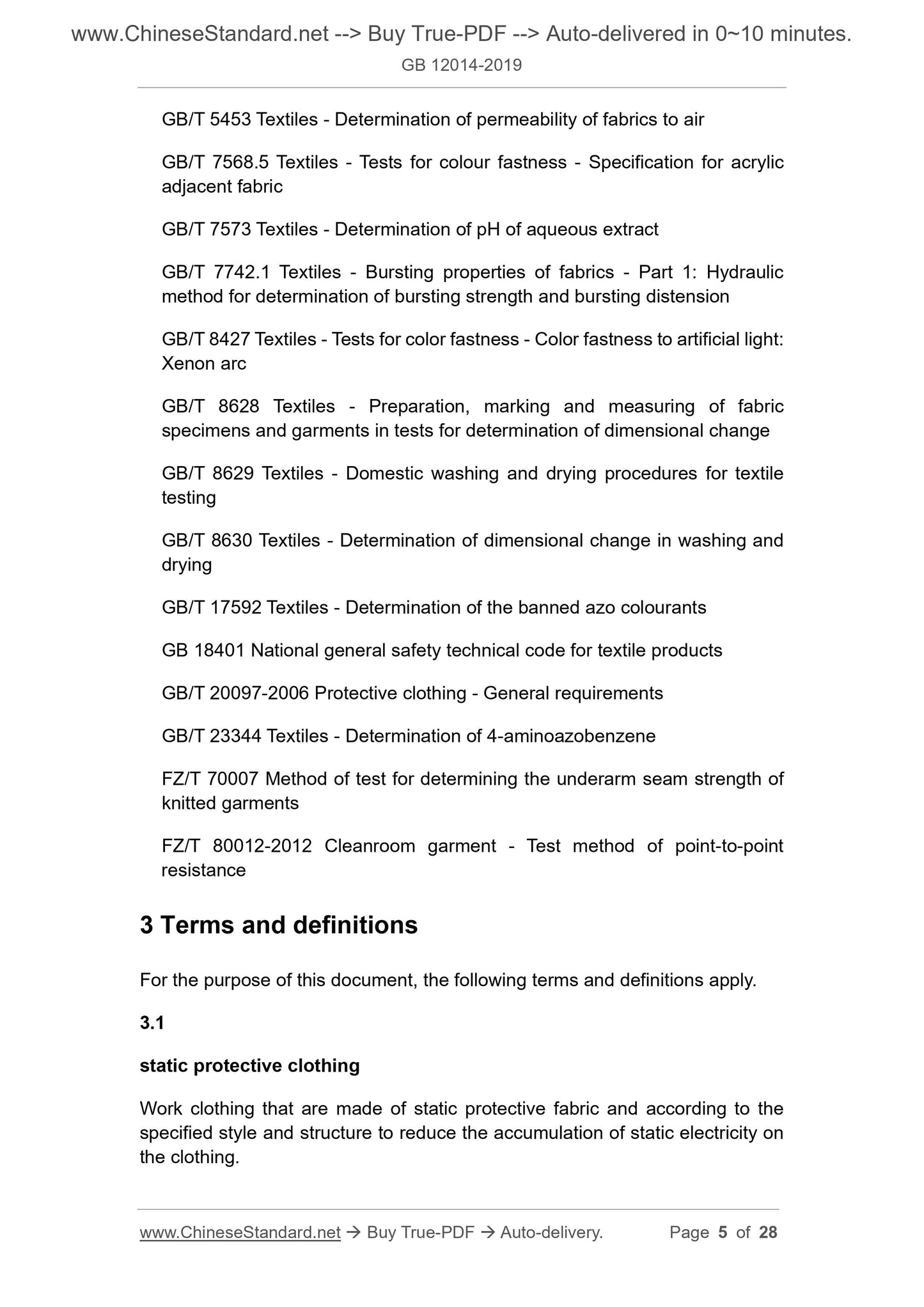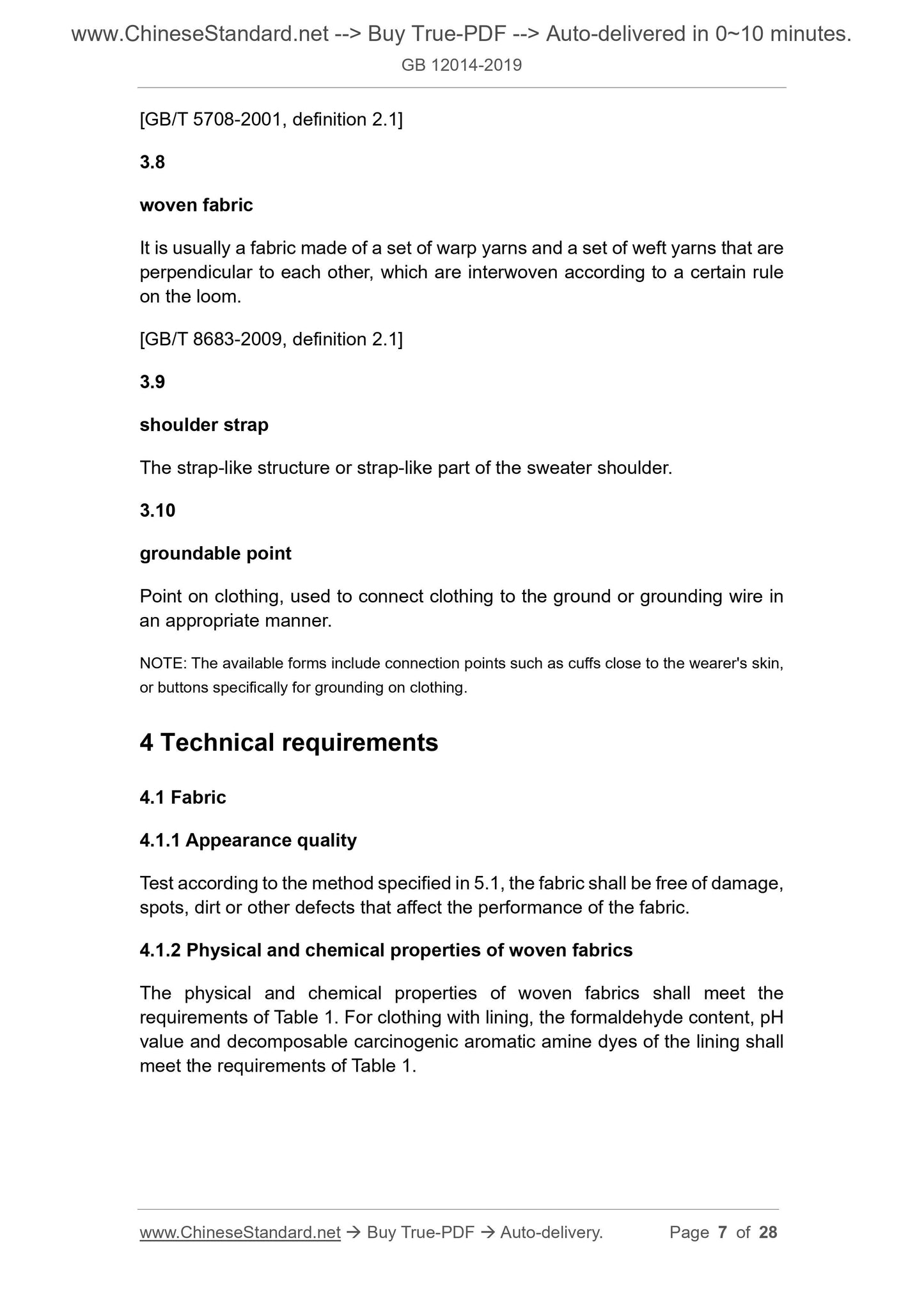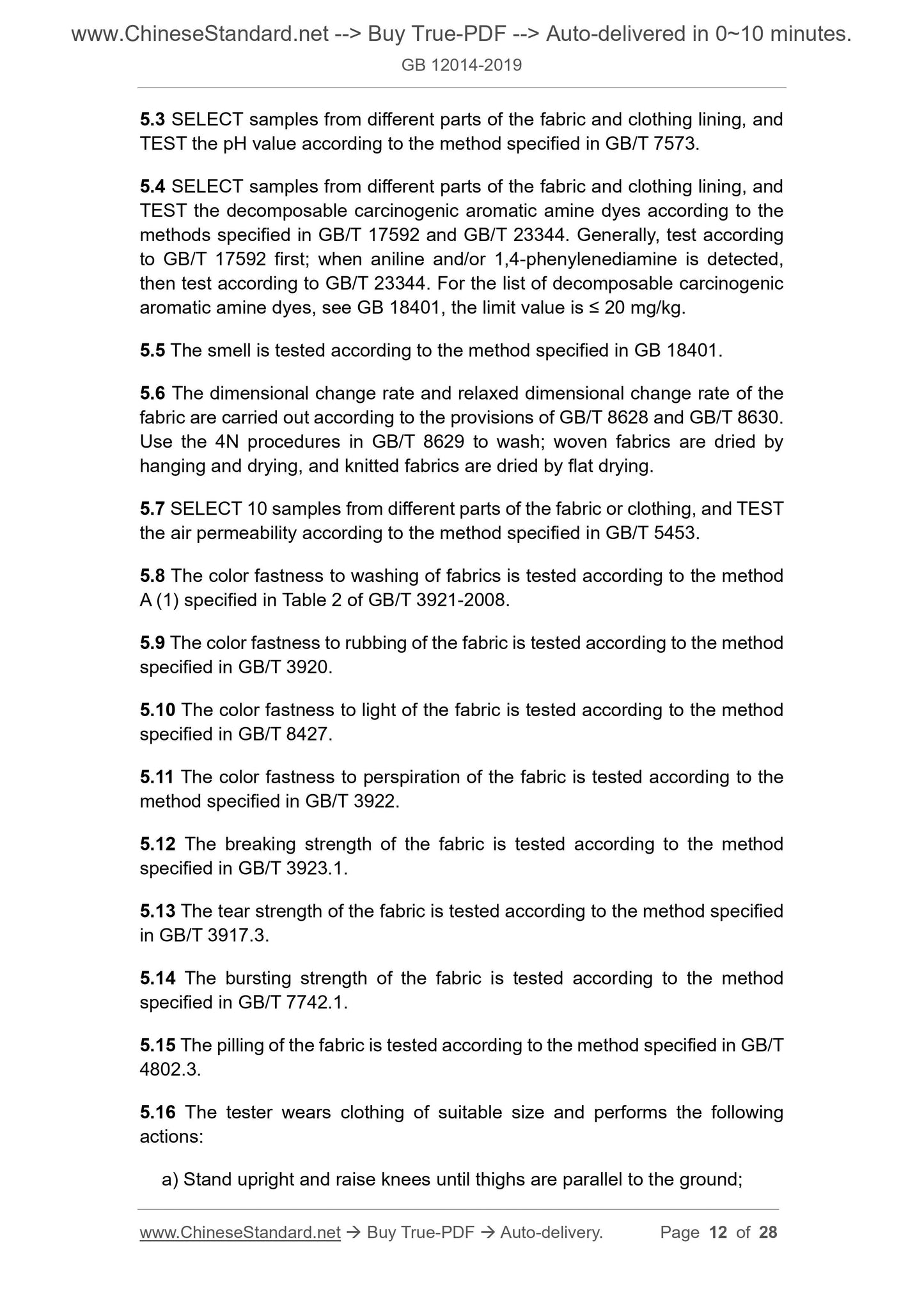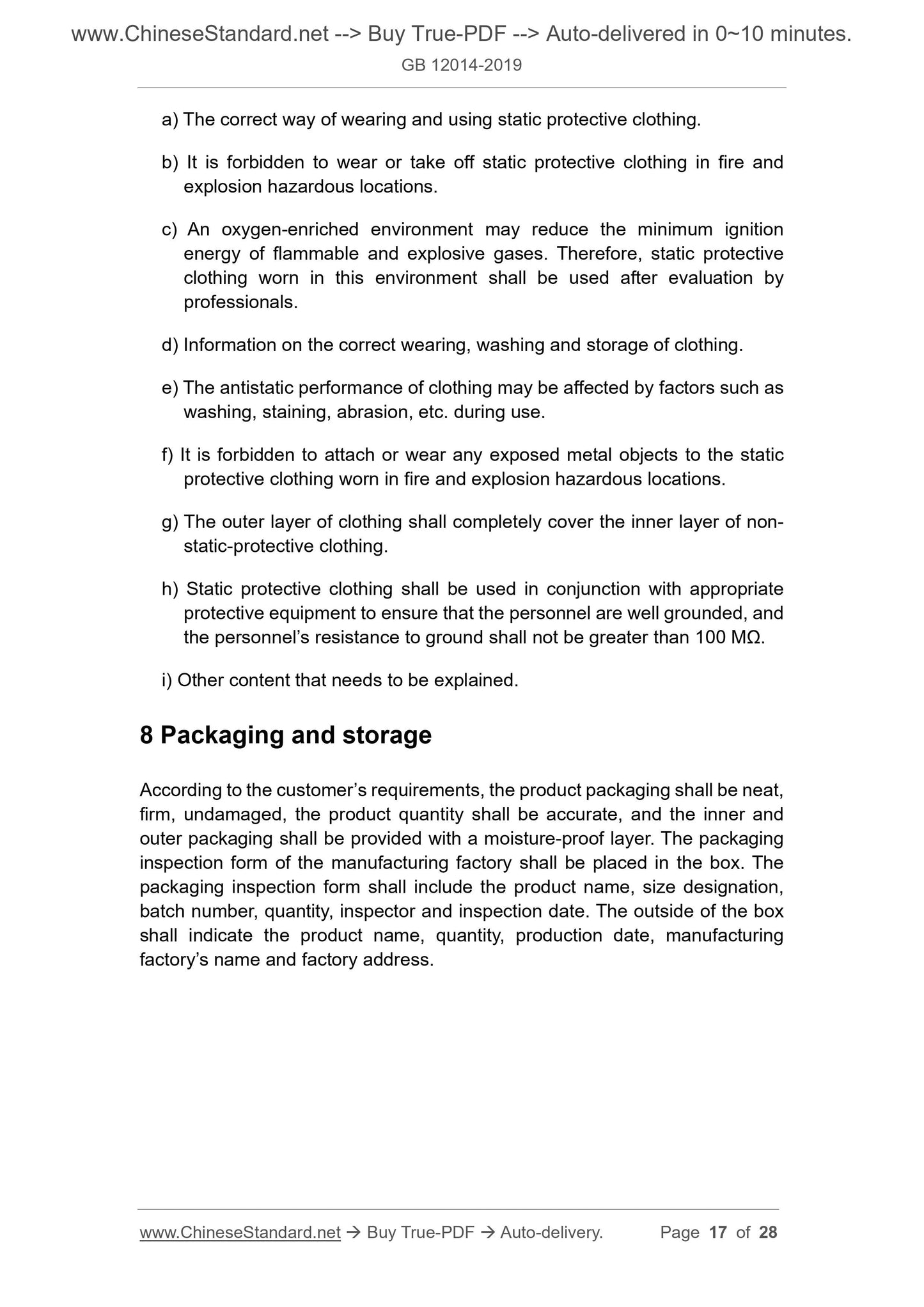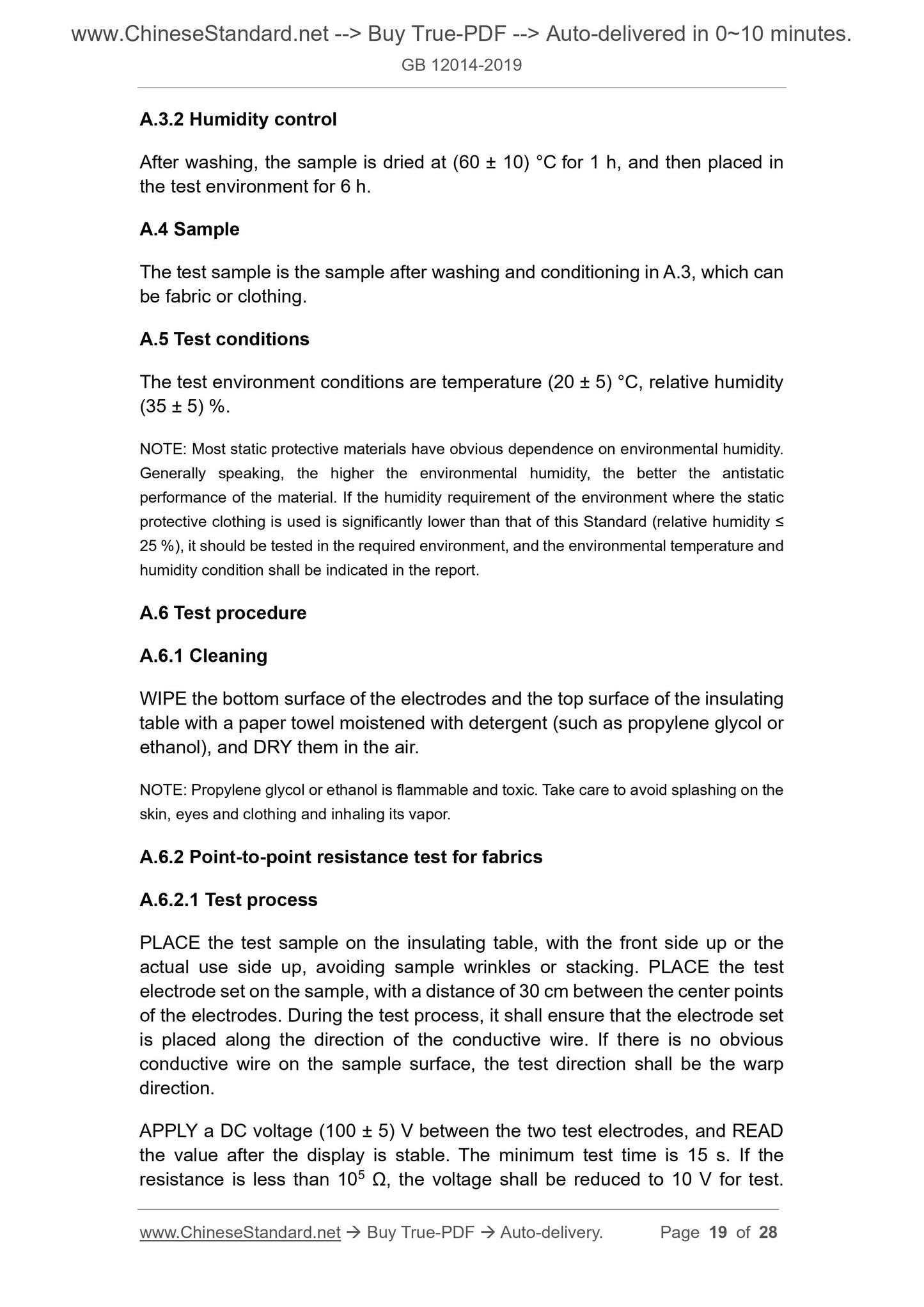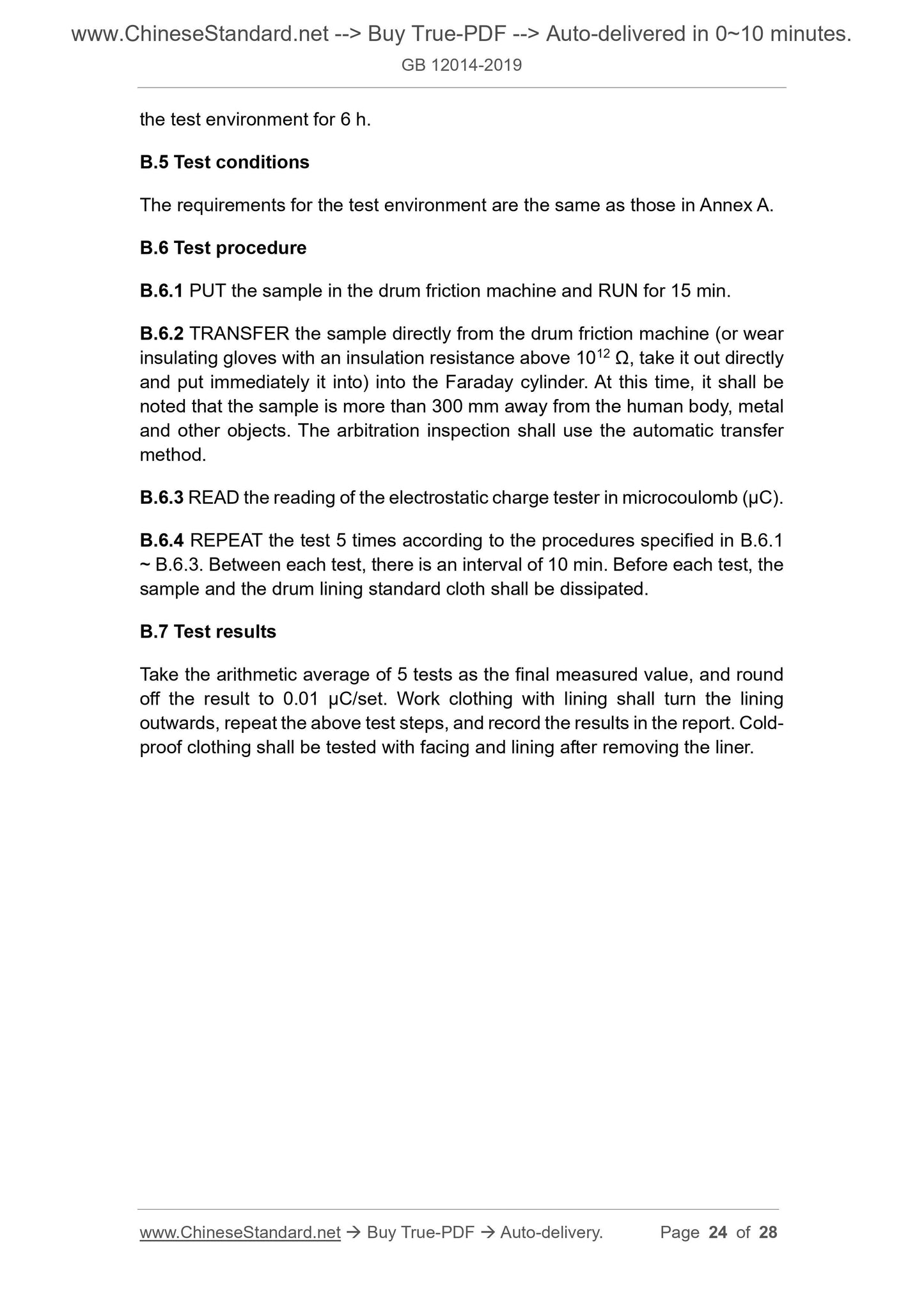1
/
su
9
PayPal, credit cards. Download editable-PDF & invoice in 1 second!
GB 12014-2019 English PDF (GB12014-2019)
GB 12014-2019 English PDF (GB12014-2019)
Prezzo di listino
$265.00 USD
Prezzo di listino
Prezzo scontato
$265.00 USD
Prezzo unitario
/
per
Spese di spedizione calcolate al check-out.
Impossibile caricare la disponibilità di ritiro
Delivery: 3 seconds. Download true-PDF + Invoice.
Get QUOTATION in 1-minute: Click GB 12014-2019
Historical versions: GB 12014-2019
Preview True-PDF (Reload/Scroll if blank)
GB 12014-2019: Protective clothing -- Static protective clothing
GB 12014-2019
GB
NATIONAL STANDARD OF THE
PEOPLE’S REPUBLIC OF CHINA
ICS 13.340.10
C 73
Replacing GB 12014-2009, GB/T 23464-2009
Protective clothing - Static protective clothing
ISSUED ON: DECEMBER 31, 2019
IMPLEMENTED ON: JULY 01, 2020
Issued by: State Administration for Market Regulation;
Standardization Administration of the People's Republic of
China.
Table of Contents
Foreword ... 3
1 Scope ... 4
2 Normative references ... 4
3 Terms and definitions ... 5
4 Technical requirements ... 7
5 Test methods ... 11
6 Inspection rules ... 13
7 Identification ... 16
8 Packaging and storage ... 17
Annex A (normative) Point-to-point resistance test method ... 18
Annex B (normative) Test method of charged electric charge ... 22
Annex C (normative) Washing method of woven fabric clothing ... 25
Annex D (normative) Washing method for knitted fabric clothing ... 27
Bibliography ... 28
Protective clothing - Static protective clothing
1 Scope
This Standard specifies the technical requirements, test methods, inspection
rules, identification, etc. of static protective clothing.
This Standard applies to static protective clothing worn in places that may
cause electric shock, fire and explosion hazards due to static electricity.
This Standard does not apply to non-woven static protective clothing and static
protective clothing for power supply voltage protection.
2 Normative references
The following referenced documents are indispensable for the application of
this document. For dated references, only the edition cited applies. For undated
references, the latest edition of the referenced document (including any
amendments) applies.
GB/T 1335.1 Standard sizing systems for garments - Men
GB/T 1335.2 Standard sizing systems for garments - Women
GB/T 2912.1 Textiles - Determination of formaldehyde - Part 1: Free and
hydrolyzed formaldehyde (water extraction method)
GB/T 3917.3 Textiles - Tear properties of fabrics - Part 3: Determination of
tear force of trapezoid-shaped test specimens
GB/T 3920 Textiles - Tests for colour fastness - Colour fastness to rubbing
GB/T 3921-2008 Textiles - Tests for colour fastness - Colour fastness to
washing with soap or soap and soda
GB/T 3922 Textiles - Tests for colour fastness - Colour fastness to
perspiration
GB/T 3923.1 Textiles - Tensile properties of fabrics - Part 1: Determination of
maximum force and elongation at maximum force using the strip method
GB/T 4802.3 Textiles - Determination of fabric propensity to surface fuzzing
and to pilling - Part 3: Pilling box method
GB/T 5453 Textiles - Determination of permeability of fabrics to air
GB/T 7568.5 Textiles - Tests for colour fastness - Specification for acrylic
adjacent fabric
GB/T 7573 Textiles - Determination of pH of aqueous extract
GB/T 7742.1 Textiles - Bursting properties of fabrics - Part 1: Hydraulic
method for determination of bursting strength and bursting distension
GB/T 8427 Textiles - Tests for color fastness - Color fastness to artificial light:
Xenon arc
GB/T 8628 Textiles - Preparation, marking and measuring of fabric
specimens and garments in tests for determination of dimensional change
GB/T 8629 Textiles - Domestic washing and drying procedures for textile
testing
GB/T 8630 Textiles - Determination of dimensional change in washing and
drying
GB/T 17592 Textiles - Determination of the banned azo colourants
GB 18401 National general safety technical code for textile products
GB/T 20097-2006 Protective clothing - General requirements
GB/T 23344 Textiles - Determination of 4-aminoazobenzene
FZ/T 70007 Method of test for determining the underarm seam strength of
knitted garments
FZ/T 80012-2012 Cleanroom garment - Test method of point-to-point
resistance
3 Terms and definitions
For the purpose of this document, the following terms and definitions apply.
3.1
static protective clothing
Work clothing that are made of static protective fabric and according to the
specified style and structure to reduce the accumulation of static electricity on
the clothing.
[GB/T 5708-2001, definition 2.1]
3.8
woven fabric
It is usually a fabric made of a set of warp yarns and a set of weft yarns that are
perpendicular to each other, which are interwoven according to a certain rule
on the loom.
[GB/T 8683-2009, definition 2.1]
3.9
shoulder strap
The strap-like structure or strap-like part of the sweater shoulder.
3.10
groundable point
Point on clothing, used to connect clothing to the ground or grounding wire in
an appropriate manner.
NOTE: The available forms include connection points such as cuffs close to the wearer's skin,
or buttons specifically for grounding on clothing.
4 Technical requirements
4.1 Fabric
4.1.1 Appearance quality
Test according to the method specified in 5.1, the fabric shall be free of damage,
spots, dirt or other defects that affect the performance of the fabric.
4.1.2 Physical and chemical properties of woven fabrics
The physical and chemical properties of woven fabrics shall meet the
requirements of Table 1. For clothing with lining, the formaldehyde content, pH
value and decomposable carcinogenic aromatic amine dyes of the lining shall
meet the requirements of Table 1.
5.3 SELECT samples from different parts of the fabric and clothing lining, and
TEST the pH value according to the method specified in GB/T 7573.
5.4 SELECT samples from different parts of the fabric and clothing lining, and
TEST the decomposable carcinogenic aromatic amine dyes according to the
methods specified in GB/T 17592 and GB/T 23344. Generally, test according
to GB/T 17592 first; when aniline and/or 1,4-phenylenediamine is detected,
then test according to GB/T 23344. For the list of decomposable carcinogenic
aromatic amine dyes, see GB 18401, the limit value is ≤ 20 mg/kg.
5.5 The smell is tested according to the method specified in GB 18401.
5.6 The dimensional change rate and relaxed dimensional change rate of the
fabric are carried out according to the provisions of GB/T 8628 and GB/T 8630.
Use the 4N procedures in GB/T 8629 to wash; woven fabrics are dried by
hanging and drying, and knitted fabrics are dried by flat drying.
5.7 SELECT 10 samples from different parts of the fabric or clothing, and TEST
the air permeability according to the method specified in GB/T 5453.
5.8 The color fastness to washing of fabrics is tested according to the method
A (1) specified in Table 2 of GB/T 3921-2008.
5.9 The color fastness to rubbing of the fabric is tested according to the method
specified in GB/T 3920.
5.10 The color fastness to light of the fabric is tested according to the method
specified in GB/T 8427.
5.11 The color fastness to perspiration of the fabric is tested according to the
method specified in GB/T 3922.
5.12 The breaking strength of the fabric is tested according to the method
specified in GB/T 3923.1.
5.13 The tear strength of the fabric is tested according to the method specified
in GB/T 3917.3.
5.14 The bursting strength of the fabric is tested according to the method
specified in GB/T 7742.1.
5.15 The pilling of the fabric is tested according to the method specified in GB/T
4802.3.
5.16 The tester wears clothing of suitable size and performs the following
actions:
a) Stand upright and raise knees until thighs are parallel to the ground;
a) The correct way of w...
Get QUOTATION in 1-minute: Click GB 12014-2019
Historical versions: GB 12014-2019
Preview True-PDF (Reload/Scroll if blank)
GB 12014-2019: Protective clothing -- Static protective clothing
GB 12014-2019
GB
NATIONAL STANDARD OF THE
PEOPLE’S REPUBLIC OF CHINA
ICS 13.340.10
C 73
Replacing GB 12014-2009, GB/T 23464-2009
Protective clothing - Static protective clothing
ISSUED ON: DECEMBER 31, 2019
IMPLEMENTED ON: JULY 01, 2020
Issued by: State Administration for Market Regulation;
Standardization Administration of the People's Republic of
China.
Table of Contents
Foreword ... 3
1 Scope ... 4
2 Normative references ... 4
3 Terms and definitions ... 5
4 Technical requirements ... 7
5 Test methods ... 11
6 Inspection rules ... 13
7 Identification ... 16
8 Packaging and storage ... 17
Annex A (normative) Point-to-point resistance test method ... 18
Annex B (normative) Test method of charged electric charge ... 22
Annex C (normative) Washing method of woven fabric clothing ... 25
Annex D (normative) Washing method for knitted fabric clothing ... 27
Bibliography ... 28
Protective clothing - Static protective clothing
1 Scope
This Standard specifies the technical requirements, test methods, inspection
rules, identification, etc. of static protective clothing.
This Standard applies to static protective clothing worn in places that may
cause electric shock, fire and explosion hazards due to static electricity.
This Standard does not apply to non-woven static protective clothing and static
protective clothing for power supply voltage protection.
2 Normative references
The following referenced documents are indispensable for the application of
this document. For dated references, only the edition cited applies. For undated
references, the latest edition of the referenced document (including any
amendments) applies.
GB/T 1335.1 Standard sizing systems for garments - Men
GB/T 1335.2 Standard sizing systems for garments - Women
GB/T 2912.1 Textiles - Determination of formaldehyde - Part 1: Free and
hydrolyzed formaldehyde (water extraction method)
GB/T 3917.3 Textiles - Tear properties of fabrics - Part 3: Determination of
tear force of trapezoid-shaped test specimens
GB/T 3920 Textiles - Tests for colour fastness - Colour fastness to rubbing
GB/T 3921-2008 Textiles - Tests for colour fastness - Colour fastness to
washing with soap or soap and soda
GB/T 3922 Textiles - Tests for colour fastness - Colour fastness to
perspiration
GB/T 3923.1 Textiles - Tensile properties of fabrics - Part 1: Determination of
maximum force and elongation at maximum force using the strip method
GB/T 4802.3 Textiles - Determination of fabric propensity to surface fuzzing
and to pilling - Part 3: Pilling box method
GB/T 5453 Textiles - Determination of permeability of fabrics to air
GB/T 7568.5 Textiles - Tests for colour fastness - Specification for acrylic
adjacent fabric
GB/T 7573 Textiles - Determination of pH of aqueous extract
GB/T 7742.1 Textiles - Bursting properties of fabrics - Part 1: Hydraulic
method for determination of bursting strength and bursting distension
GB/T 8427 Textiles - Tests for color fastness - Color fastness to artificial light:
Xenon arc
GB/T 8628 Textiles - Preparation, marking and measuring of fabric
specimens and garments in tests for determination of dimensional change
GB/T 8629 Textiles - Domestic washing and drying procedures for textile
testing
GB/T 8630 Textiles - Determination of dimensional change in washing and
drying
GB/T 17592 Textiles - Determination of the banned azo colourants
GB 18401 National general safety technical code for textile products
GB/T 20097-2006 Protective clothing - General requirements
GB/T 23344 Textiles - Determination of 4-aminoazobenzene
FZ/T 70007 Method of test for determining the underarm seam strength of
knitted garments
FZ/T 80012-2012 Cleanroom garment - Test method of point-to-point
resistance
3 Terms and definitions
For the purpose of this document, the following terms and definitions apply.
3.1
static protective clothing
Work clothing that are made of static protective fabric and according to the
specified style and structure to reduce the accumulation of static electricity on
the clothing.
[GB/T 5708-2001, definition 2.1]
3.8
woven fabric
It is usually a fabric made of a set of warp yarns and a set of weft yarns that are
perpendicular to each other, which are interwoven according to a certain rule
on the loom.
[GB/T 8683-2009, definition 2.1]
3.9
shoulder strap
The strap-like structure or strap-like part of the sweater shoulder.
3.10
groundable point
Point on clothing, used to connect clothing to the ground or grounding wire in
an appropriate manner.
NOTE: The available forms include connection points such as cuffs close to the wearer's skin,
or buttons specifically for grounding on clothing.
4 Technical requirements
4.1 Fabric
4.1.1 Appearance quality
Test according to the method specified in 5.1, the fabric shall be free of damage,
spots, dirt or other defects that affect the performance of the fabric.
4.1.2 Physical and chemical properties of woven fabrics
The physical and chemical properties of woven fabrics shall meet the
requirements of Table 1. For clothing with lining, the formaldehyde content, pH
value and decomposable carcinogenic aromatic amine dyes of the lining shall
meet the requirements of Table 1.
5.3 SELECT samples from different parts of the fabric and clothing lining, and
TEST the pH value according to the method specified in GB/T 7573.
5.4 SELECT samples from different parts of the fabric and clothing lining, and
TEST the decomposable carcinogenic aromatic amine dyes according to the
methods specified in GB/T 17592 and GB/T 23344. Generally, test according
to GB/T 17592 first; when aniline and/or 1,4-phenylenediamine is detected,
then test according to GB/T 23344. For the list of decomposable carcinogenic
aromatic amine dyes, see GB 18401, the limit value is ≤ 20 mg/kg.
5.5 The smell is tested according to the method specified in GB 18401.
5.6 The dimensional change rate and relaxed dimensional change rate of the
fabric are carried out according to the provisions of GB/T 8628 and GB/T 8630.
Use the 4N procedures in GB/T 8629 to wash; woven fabrics are dried by
hanging and drying, and knitted fabrics are dried by flat drying.
5.7 SELECT 10 samples from different parts of the fabric or clothing, and TEST
the air permeability according to the method specified in GB/T 5453.
5.8 The color fastness to washing of fabrics is tested according to the method
A (1) specified in Table 2 of GB/T 3921-2008.
5.9 The color fastness to rubbing of the fabric is tested according to the method
specified in GB/T 3920.
5.10 The color fastness to light of the fabric is tested according to the method
specified in GB/T 8427.
5.11 The color fastness to perspiration of the fabric is tested according to the
method specified in GB/T 3922.
5.12 The breaking strength of the fabric is tested according to the method
specified in GB/T 3923.1.
5.13 The tear strength of the fabric is tested according to the method specified
in GB/T 3917.3.
5.14 The bursting strength of the fabric is tested according to the method
specified in GB/T 7742.1.
5.15 The pilling of the fabric is tested according to the method specified in GB/T
4802.3.
5.16 The tester wears clothing of suitable size and performs the following
actions:
a) Stand upright and raise knees until thighs are parallel to the ground;
a) The correct way of w...
Share
